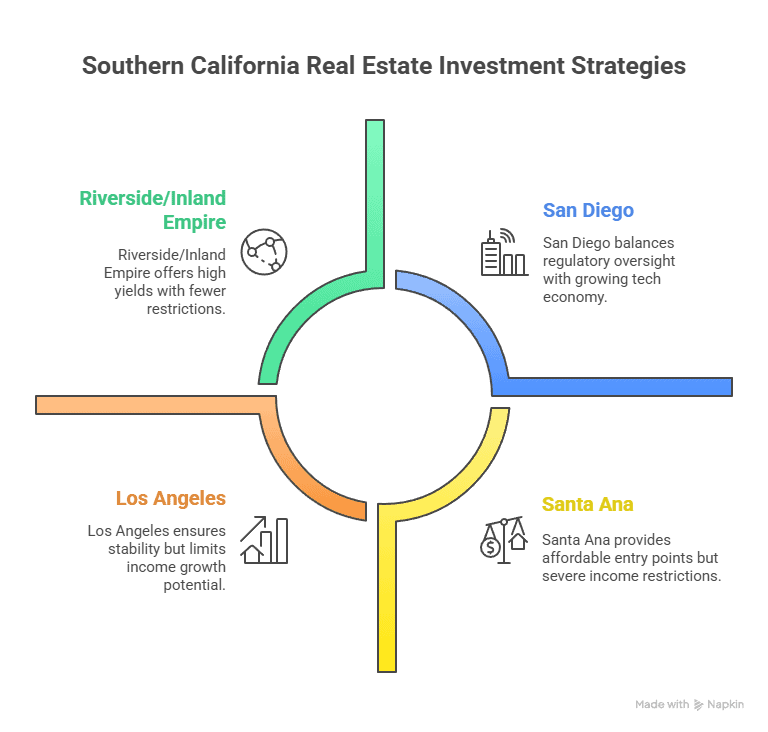After 18 years in commercial real estate, I’ve witnessed firsthand how rent control policies shape investment decisions across Southern California. As property values continue climbing and housing affordability becomes increasingly challenging, the need to compare rental control in LA with its neighboring major cities has never been more critical for landlords, investors, and tenants alike. Let me walk you through the complex landscape of rent stabilization laws that could significantly impact your real estate decisions.
Key Takeaways
- Los Angeles leads with strict controls: LA caps rent increases at 3-4% annually for older properties, while surrounding cities have varying levels of regulation.
- State law provides baseline protection: California’s AB 1482 limits increases to 5% plus CPI (max 10%) for most properties over 15 years old across all regions.
- Regional differences create opportunities: Understanding each city’s unique rent control landscape helps investors and landlords make informed property decisions.
Los Angeles Rent Control: The Baseline Standard

The city of Los Angeles operates under one of California’s most comprehensive rent stabilization frameworks. The city’s Rent Stabilization Ordinance (RSO) applies to most multi-family rental units built before October 1978, covering approximately 600,000 rental units citywide.
Current LA Rent Control Highlights
The allowable rent increase cap stands at 3% for the period from July 1, 2025, through June 30, 2026, which represents a decrease from the previous year’s 4% limit. Landlords can add utility adjustments of 1% if they provide gas service and another 1% for electricity service to tenants. Just cause eviction protection requires landlords to have valid legal reasons for tenant removal, preventing arbitrary displacement.
The city mandates relocation assistance for no-fault evictions, ensuring tenants receive financial support when displaced through no fault of their own. All covered properties must be registered with the Los Angeles Housing Department to ensure compliance monitoring.
The RSO’s tenant protections extend beyond rent increases. Property owners must navigate strict eviction procedures, provide substantial relocation assistance, and comply with detailed notification requirements. These regulations create stability for tenants but require careful compliance planning for landlords.
Orange County: A Tale of Two Approaches
Orange County presents a fascinating contrast to LA’s comprehensive controls, with most cities operating under California’s statewide AB 1482 protections rather than implementing local ordinances.
Santa Ana: Orange County’s Rent Control Pioneer
Santa Ana stands alone as Orange County’s only city with comprehensive rent stabilization measures. Implemented in November 2021, the city’s ordinance represents one of California’s most restrictive approaches with an ultra-low annual rent increase cap of 3% or 80% of CPI, whichever is less. The current rate stands at 2.54% for September 2024 through August 2025. The ordinance provides comprehensive coverage for buildings constructed before February 1995. Enhanced tenant protections include just cause eviction requirements after only 30 days, compared to 12 months under state law. The city requires substantial relocation assistance of up to three months’ rent for certain no-fault evictions.
Santa Ana’s aggressive approach has sparked significant controversy. Property owners argue these restrictions make rental housing financially unviable, while tenant advocates praise the affordability protections.
Anaheim and Other OC Cities: State Law Compliance
Most Orange County cities, including Anaheim, rely on California’s AB 1482 framework rather than implementing local controls. These cities allow standard increases of 5% plus local CPI, capped at 10% annually. The current Orange County rate stands at approximately 8.8% for properties subject to AB 1482. Just cause protections apply after 12 months of tenancy, following state guidelines. Some cities maintain limited local variations, particularly for affordable housing-specific regulations, but most avoid additional restrictions beyond state requirements.
This approach provides more flexibility for property owners while maintaining basic tenant protections. The higher allowable increases reflect market-rate adjustments tied to regional inflation.
San Diego: Balancing Act Between Protection and Flexibility
San Diego County operates under a hybrid system combining state protections with local enhancements. The city doesn’t impose rent control per se, but has strengthened tenant protections significantly.
San Diego’s Unique Approach
San Diego takes a distinctive path by avoiding local rent caps and instead relying on AB 1482’s 5% plus CPI formula. The current maximum stands at 8.6% for August 2024 through July 2025, increasing to 8.8% for the 2025-2026 period. The city has implemented enhanced eviction protections that exceed state minimums with stronger just cause requirements. Property owners must provide substantial relocation assistance of 2-3 months’ rent for no-fault evictions. Unlike state law’s 12-month requirement, San Diego offers day-one protections that begin immediately upon tenancy.
San Diego’s model focuses on eviction protection rather than rent control, recognizing that displacement often causes more harm than gradual rent increases. This approach appeals to landlords seeking reasonable return opportunities while providing meaningful tenant security.
Riverside County: Market-Rate Focus with Targeted Controls
The Inland Empire operates primarily under state regulations, with limited local rent control measures. Riverside County’s approach emphasizes market-driven solutions while protecting vulnerable populations.
Riverside Area Characteristics
The Inland Empire primarily operates under state law compliance, with AB 1482 caps applying at 5% plus CPI with a maximum of 10% annually. The region maintains specific protections for mobile home parks through targeted ordinances addressing this vulnerable housing segment. Most cities in Riverside County avoid additional restrictions beyond state requirements, creating limited local variations in rental regulations. This approach has fostered an investment-friendly climate with fewer regulatory barriers compared to coastal areas, making it attractive for property investors seeking straightforward compliance requirements.
Riverside’s approach reflects the region’s historical role as an affordable alternative to coastal markets. However, recent investor activity and rising rents have prompted discussions about potential enhanced protections.
Comparative Analysis: Key Differences That Matter
Rent Increase Limits
Los Angeles maintains the most restrictive approach at 3% annually, while Santa Ana operates with an even lower current rate of 2.54%. San Diego follows state guidelines allowing 8.6-8.8% increases depending on the period. Most Orange County cities permit 8.8% under state law parameters. Riverside County also adheres to the 8.8% state law maximum, creating consistency across the Inland Empire region for increasing rent.
Implementation Timing
Los Angeles operates under an established system dating back to 1978, providing decades of precedent and regulatory stability. Santa Ana implemented its new ordinance in 2021 and continues evolving its enforcement mechanisms. San Diego introduced recent enhancements in 2023, strengthening tenant protections while maintaining market flexibility. Other areas primarily rely on the state framework established in 2020 through AB 1482.
Eviction Protections
Los Angeles maintains comprehensive just cause requirements with detailed procedural safeguards for tenants. Santa Ana offers the strictest protections with a 30-day threshold for just cause requirements. San Diego provides enhanced protections that exceed state minimums through local ordinances. Other areas follow state law minimums requiring 12-month tenancy thresholds before just cause protections apply.
Relocation Assistance
Los Angeles requires relocation assistance that varies depending on specific circumstances and tenant demographics. Santa Ana mandates up to three months’ rent for qualified no-fault evictions, representing some of the highest assistance levels statewide. San Diego requires 2-3 months’ rent based on the tenant’s age and disability status. Other areas provide the state minimum of one month’s rent for qualifying no-fault evictions.
Investment Implications: Strategic Considerations
Understanding these regulatory differences creates opportunities for informed investment decisions. Each market presents distinct risk-reward profiles:

Los Angeles Market:
- Pros: Stable, established regulations; strong tenant base
- Cons: Limited income growth potential; complex compliance requirements
- Best for: Long-term wealth preservation; experienced landlords
Santa Ana Market:
- Pros: Affordable entry points; strong rental demand
- Cons: Severe income restrictions; regulatory uncertainty
- Best for: Value-play investors; social impact investing
San Diego Market:
- Pros: Balanced approach; growing tech economy
- Cons: High entry costs; moderate restrictions
- Best for: Quality-focused investors; professional property management
Riverside/Inland Empire:
- Pros: Higher yields, fewer restrictions, growth potential
- Cons: Economic volatility; commuter dependency
- Best for: Cash flow investors; first-time landlords
Tenant Perspective: Protection Levels Across Markets
Santa Ana and Los Angeles offer the strongest tenant protections through strict rent caps and enhanced eviction safeguards, though this security often limits housing mobility. San Diego balances meaningful eviction protections with market-rate adjustments, helping tenants avoid displacement without restricting rent growth.
Orange County and Riverside County cities provide state-mandated minimums with essential safeguards but fewer restrictions on market dynamics. These markets allow greater tenant mobility while offering reduced protection against significant rent increases tied to market conditions.
Future Trends and Legislative Outlook
More cities are considering local rent control ordinances as housing costs rise, with Costa Mesa exploring Santa Ana-style regulations. California legislators continue proposing AB 1482 modifications while economic pressures from inflation and housing supply constraints influence policy discussions.
The ongoing tension between tenant protection and housing supply drives policy debates, with developers arguing that strict controls discourage construction. Regional economic factors and changing political landscapes will likely determine which cities adopt stricter local controls versus state frameworks.
Compliance Best Practices for Multi-Market Landlords
Multi-jurisdiction property management requires systematic record-keeping, local legal expertise, and technology solutions that automate compliance tasks. Proactive tenant communication and staying informed about regulatory changes through industry associations protect investment strategies.
Successful landlords develop standardized processes customizable for local requirements while maintaining portfolio consistency. Regular staff training on jurisdiction-specific rules and comprehensive compliance calendars prevents violations and maintains positive tenant relationships.
Economic Impact Analysis
Strict controls in LA and Santa Ana may discourage new construction, while moderate approaches in San Diego maintain development incentives. Areas with strong controls often see higher initial rents compensating for limited increase potential, creating value-add opportunities.
Broader implications include reduced housing supply as developers focus on less-regulated markets and decreased tenant mobility in highly protected areas. Property values reflect regulatory constraints, with rent-controlled buildings trading at cap rate premiums, accounting for income limitations.
Strategic Recommendations for Different Investor Profiles
New investors should start in Riverside or non-Santa Ana Orange County markets, where regulations are straightforward and yields are higher. Experienced investors may find Los Angeles opportunities despite complexity, while value investors can explore Santa Ana’s restrictive but stable environment.
Growth investors often prefer San Diego’s balanced approach with economic potential and reasonable regulations. Portfolio diversification across markets helps balance regulatory risk while capturing different return profiles from cash flow to appreciation strategies.
Frequently Asked Questions
Which city has the strictest rent control laws?
Do single-family homes fall under rent control in these markets?
How often can landlords raise rent in these different cities?
What happens if a landlord violates rent control laws?
Are there exemptions for major property improvements?
Conclusion
Navigating rent control variations across Southern California requires understanding each market’s unique approach to tenant protection and landlord flexibility. Los Angeles and Santa Ana prioritize strict tenant protections through low rent caps, while San Diego balances security with market dynamics, and Orange County plus Riverside County rely primarily on state guidelines. These differences create distinct opportunities for investors willing to match their strategies with appropriate regulatory environments.
After nearly two decades in commercial real estate, I’ve seen how regulatory knowledge translates directly into investment success. Whether you’re evaluating your first rental property or expanding an existing portfolio, understanding these rent control nuances can significantly impact your returns and risk profile. Let’s discuss how these market differences align with your specific investment goals and explore opportunities that make sense for your situation.




